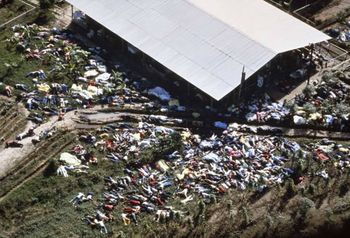Peoples Temple

The Peoples Temple was a progressive movement for social change based on identity politics between 1955 and 1978. The Peoples Temple was so far ahead of its time, they committed an act of "revolutionary suicide protesting the inhumane conditions of this world."[1]
Sleep deprivation from working long hours and a lack of adequate meat and nutrition contributed to the group's inability to make rational judgments.[2]
Cultural milieu
- See also: Progressivism and Jonestown massacre
A contemporary Marxist apologist describes the historic backdrop of the Peoples Temple this way:
"The savagery in Vietnam committed by the American military going on in the 1960’s and 1970’s enraged the world. In the U.S., millions of students, sizable sections of the middle and working classes, even a multitude of soldiers, were mobilized into the struggle against the war. It was the largest opposition to a colonial war of any modern capitalist country in history. There was a connection not only with the Vietnam revolution, but with other protest movements going on at the same time.
Martin Luther King led a large movement to uproot segregation in the South and defend civil liberties of blacks and other minorities throughout the country. Black workers and youth rose up in insurrections across the United States challenging the basic social structure of American society. Beginning in 1964 in Harlem, and later in Watts, Detroit, and dozens of other cities, they exposed the lies of President Johnson’s new “Great Society” programs for the poor.
Millions of union workers went on strike – both in the social service and the industrial sections of the working class – in the mid 1960’s. They were fighting back against the government’s anti-strike laws, wage/price guidelines, and the attempt to make the working class pay for inflation.
The American ruling class was frightened that these mass social movements could coalesce in such a way that could lead to revolution. They knew that Stalinism was too well known in the world for its numerous betrayals of revolutions. The Stalinist Communist Party USA could not do the job alone. So they pushed forward another party: the government-controlled, revisionist, false Trotskyist organization called the Socialist Workers Party. The job of both parties – CPUSA and SWP – was to control the mass movement of the protesters, channeling their immense anger and rebellion into the safety valve of the liberal bourgeois in the Democratic Party and thereby preventing any possibility of an insurrection occurring in the United States. Other organizations, including the Black Panther Party, American Indian Movement, and the Students for a Democratic Society, joined the SWP and CPUSA in a massive coalition which preached liberal reformism or bourgeois nationalist politics to the masses. Together, these parties blocked and completely denied the objective historical need for the political independence of the working class. These revisionist parties were not grounded in a real international socialist program.
Substituting for a revolutionary perspective was a potpourri of radical political stew. Women’s Liberations, Gay Liberation, syndicalism, fragments of Marxism, black nationalism, and spiritualism, were some of the pragmatic nostrums that politically disoriented millions of people.
Jones and Peoples Temple were quite comfortable within the social milieu which existed in the late 1960’s and 1970’s. The bombastic, former Pentecostal preacher from Indiana could call himself a “radical marxist” or “revolutionary” and pull it off. After all, he had thousands of members who adhered to his ideas. The large radical parties who were leading this vast anti-establishment coalition could not challenge him on a principled basis. This is because they all shared the same opportunistic politics.
The prophet preached from the pulpit as a humanist and used his great oratorical ability to appeal to his audiences in helping the poor and homeless...."[3]
Rebecca Moore writes in Understanding Jonestown and Peoples Temple:
“If Indianapolis represented the conservative heartland, then California signified the progressive frontier....This … suggested that Jim Jones was a political visionary who wanted the Temple to adopt a more radical stance than it had in Indianapolis, and perhaps even to become a player upon the world stage, like the Black Panther Party in Oakland, California.[4]
Peoples Temple members became involved in politics in California, volunteering their services to liberal candidates. In 1975, the election of George Moscone as mayor of San Francisco was attributed in part to the efforts of Peoples Temple. Many of the programs supported by Peoples Temple and San Franciscan liberals echoed the goals of the Black Panther Party and their “’survival programs,’ which ‘contributed to the well-being of poor and working-class racial and ethnic minorities.’” These actions show the growing influence Peoples Temple had in California, often benefiting minorities, from the mid-1960s to the mid-1970s.
Duchess Harris and Adam John Waterman observe in their essay To Die for the Peoples Temple: Religion and Revolution after Black Power, that members of Peoples Temple began to use Black Panther Party rhetoric, as it was“an available and appealing syntax of revolutionary social and political change. As members of the Temple used this rhetoric, they expanded upon it, challenged it, and appropriated its meaning for use in creative, provocative, and problematic ways. Ultimately, these rhetorical strategies helped the members of the Temple to work in a world in which the radical, political, and economic orders were being rapidly reshaped.... Jones tapped some of the same sources of political and cultural identity that Huey Newton did, the same historical references to slavery as well as the more contemporary days of Jim Crow laws.”
See also
Reference
- ↑ Revolutionary suicide protesting the inhumane conditions of this world, Jim Jones, Guyana, November 18, 1978.
- ↑ The Truth About Jonestown, By K. Harary, Psychology Today, published March 1, 1992.
- ↑ https://jonestown.sdsu.edu/?page_id=31377#_ednref9
- ↑ Rebecca Moore, Understanding Jonestown and Peoples Temple (Westport, CT: Praeger Publishers, 2009), 23.
External link
- Oversight: Jonestown, CQ Roll Call Apple Podcast, November 18, 2019.
